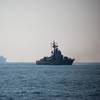Building of ATBs Has Become Big Business For Gulf Coast and Great Lakes Shipyards
All of the growth markets in the commercial marine marketplace have something to do with petroleum. Supply and crew/supply boats directly support drilling activity and Articulated Tug Barges (ATB) distributes crude, refined or an oil byproduct to refiners or distributors.
The ATB represents a big advance in transporting these oil products over a pushboat pushing a tow of petroleum barges. Typically an ATB is one large barge with capacity from 80,000 to 160,000 barrels being pushed by a tug that fits into a notch in the barge. An advanced coupling system permits easy coupling and uncoupling of the two units.
With typical barge and pushboat units, the coupling system uses winches and wire ropes to lash the barges together and also secure the barge tow to the pushboat. The ATB coupling system uses a much simpler device. First the barge and the tug fit together in a notch built into the stern of the barge. A vertical ladder system is built into the barge notch to accept powered rams that project from the tugs side engaging the ladder system in a mechanical fit. This connection permits full pitch of the two units independently, but roll, heave and yaw movements are constrained so the two unit acts as one.
"Since an ATB handles in the water more like one continuous hull rather than a separate barge and tug, speed of an ATB is perhaps increased by 35 percent," said Craig Reinauer, CEO of Reinauer Transportation Companies, a lading transporter of petroleum products. "Also, the barge of an ATB can be essentially unmanned while the tug and barge vessels cannot," Reinauer added.
ATBs are not a revolutionary new tug/barge development. About 40 units are in the fleets of the various transportation fleets that work primarily on the East and Gulf
Coasts and on the Great Lakes. Some were built in the 1970's and subsequently updated in the last 20 years.
The driving force behind the resurgence of the building of these tug/barge units is OPA-90. The transportation companies know their old single hull barges will be forced out of their fleets by OPA-90 legislation, so the replacements being built are more likely
than not the double-hulled ATB units.
Many of the nation's larger "second tier" shipyards have active construction and marketing programs for ATBs. Those shipyards are:
Alabama Shipyard, Mobile, Ala.
Bollinger Shipyards, Lockport, La.
Halter Marine Group, Gulfport, Miss.
Manitowoc Marine Group, Manitowoc, Wisc.
Each of the above yards has more than one project under construction at this time and Alabama Shipyard has delivered several of these vessels.
Alabama Shipyard
Reinauer Transportation Company of Long Island, NY, has taken delivery of two ATBs from Alabama Shipyard and has placed an order for a third. The 77-year-old company delivers petroleum products on the East Coast and into the Great Lakes via 30 barges and 19 tugs. The company also has a number of tugs in Boston Harbor, as they are the largest ship handler in the port.
The first ATB built by Alabama Shipyard for Reinauer was the twin-screw 7,200 hp tug Nicole Leigh Reinauer and the 460-ft. by 72-ft. 135,000-barrel barge RC 135 using an Intercon coupler manufactured by Intercontinental Engineering Company of Kansas City, Mo. It was delivered in December 1999. The tug is powered by a pair of Caterpillar 3612 diesels that spin Bird Johnson five-blade 140-in. propellers through Lufkin reduction/reversing gears.
That was followed by the Christian Reinauer, using a tug with the same specs but a larger 143,000-barrel barge that began working in January 2002.
Now on order is the Meredith C. Reinauer, a 7,200 hp tug pushing a 150,000-barrel barge that was started in April 2002 and should deliver in late 2002/early 2003.
Another ATB customer for Alabama Shipyard is Allied Transportation of Norfolk, Va. In April 2002, Alabama Shipyard delivered an 8,000 hp tug and 129,000 barrel barge to Allied. The Intercon tug-barge articulated connection system is used on the ATB. Seahawk, the 124-ft. long tug is powered by a pair of EMD 16-710 diesels delivered 4,000 hp each at 900 rpm pushing the ATB 11-12 knots.
The Seahawk's barge carries caustic soda and other chemical products from the Gulf of Mexico to customers on the southeastern part of the East Coast. The barge can hold up to five different chemical products. Each pair of tanks has its own piping and pumping system and to insure that extremely corrosive products are carried safely with no contamination, two of the tank sets and their pumping and piping are made of stainless steel.
Penn Maritime with offices in Stamford, Conn., Slidell, La. and Staten Island, NY is the largest U.S. coastal transporter of heated asphalt products. Currently, Alabama is building Penn Maritime a 129,000-barrel double-hull barge and a 7,000 hp tug using an Intercon articulated coupling system. .
Bollinger Shipyards
One of the most interesting ATB projects in 2002 is the series of four double-hulled barges Bollinger Shipyards, Lockport, La. is building for K-Sea Transportation Corp. of New York. Two of the barges will hold 80,000 barrels of clean refined petroleum products and two will have 100,000-barrel capacity. K-Sea is also outfitting four of their existing tugs with the Acomarin articulated coupling system to form true ATB units. The Acomarin JAK Coupler System is a Finnish design and is said to be 35 percent lighter than competitive systems, uses no cast steel components and uses ordinary compressed air to active the coupling "pins" on the tug. The barge uses the "ladder" device, similar to other coupling systems.
In July Bollinger delivered the first of these pairs, barge DBL 101, a 100,000 barrel all oceans tank barge and the existing tug Tasman Sea that had the "tug end" of the Acomarin coupling system added at Bollinger Gulf Repair, Harvey, La. The barge was built at the Bollinger-Gretna facility.
K-Sea is one of the largest transporters of petroleum products in the U.S. with a fleet of over 60 vessels. The barges will feature double block cargo segregation, segregated ballast, cargo monitoring and vapor recovery systems.
Modules for the other barges are being fabricated at Bollinger Marine Fabricators in Amelia, La. The modules will be transported to Bollinger Gretna for final assembly.
In a real competitive coup, Bollinger has also received a contract to build two 6,000 hp tugs and two double-hulled barges of 110,000 and 135,000-barrel capacity from Bouchard Coastwise Management Corp, Hicksville, N.Y. Earlier this order had been won by the Halter Marine Group, Gulfport, Miss., but the pair of ATBs was later awarded to Bollinger.
The tugs will be built at Bollinger's main office shipyard in Lockport, La. and the barges constructed at Bollinger-Gretna in Harvey, La. Delivery of the first ATB is slated for second quarter 2003 with the second unit a year later.
Halter Marine Group
Until June of this year there were no ATBs working regularly on the West Coast.
Since then, West Coast marine giant Crowley Maritime has been sailing the 9,200 hp tug Sea Reliance with a 155,000-barrel double-hulled barge. The Oakland, Calif.-based company is using its subsidiary Vessel Management Services to operate this ATB and the three that will follow it into the fleet.
These ATBs will carry clean refined petroleum products along the West Coast from the Columbia River to Central America. An Intercon articulated coupling system is fitted to the notch in the barge and to the bow of the tug.
Halter Marine, Gulfport, Miss. built the 126-ft. by 19-ft. Sea Reliance and its 155,000 barrel barge. Vessel design was by Vessel Management Services and Halter Marine.
The tug is powered by a pair of Caterpillar 3612 electronically controlled diesels rated at 4,600 hp each. Reintjes reduction/reversing gears couple each engine to 144-in. Bird Johnson props.
The 500-ft. long barge can carry 19,000 tons of cargo or 155,000 gallons of petroleum products in its 12 tanks. The barge is piped with four separate pumping and piping systems so that four different products can be carried in the tanks.
The second Crowley ATB, the tug Sound Reliance and its 155,000-barrel barge will be delivered later this year.
An interesting feature of the tugs is that they are double-hulled on the sides as well as bottoms. Since the tugs can carry 200,000 gallons of fuel, complete double hulling was an appropriate environmental response.
Manitowoc Marine
On the Great Lakes two more Crowley ATBs are being built also with end of the year delivery dates. The Manitowoc Company, Manitowoc, Wisc. is building a pair of 9,200 hp tugs Ocean Reliance and Coastal Reliance at its Marinette Marine
Shipyard in Marinette, Wisc. and the 155,000-barrel tank barges at Bay Shipbuilding, Sturgeon Bay, Wisc. In mid-July, the first tug Ocean Reliance was launched at Marinette Marine.
Subscribe for
Maritime Reporter E-News
Maritime Reporter E-News is the maritime industry's largest circulation and most authoritative ENews Service, delivered to your Email five times per week










